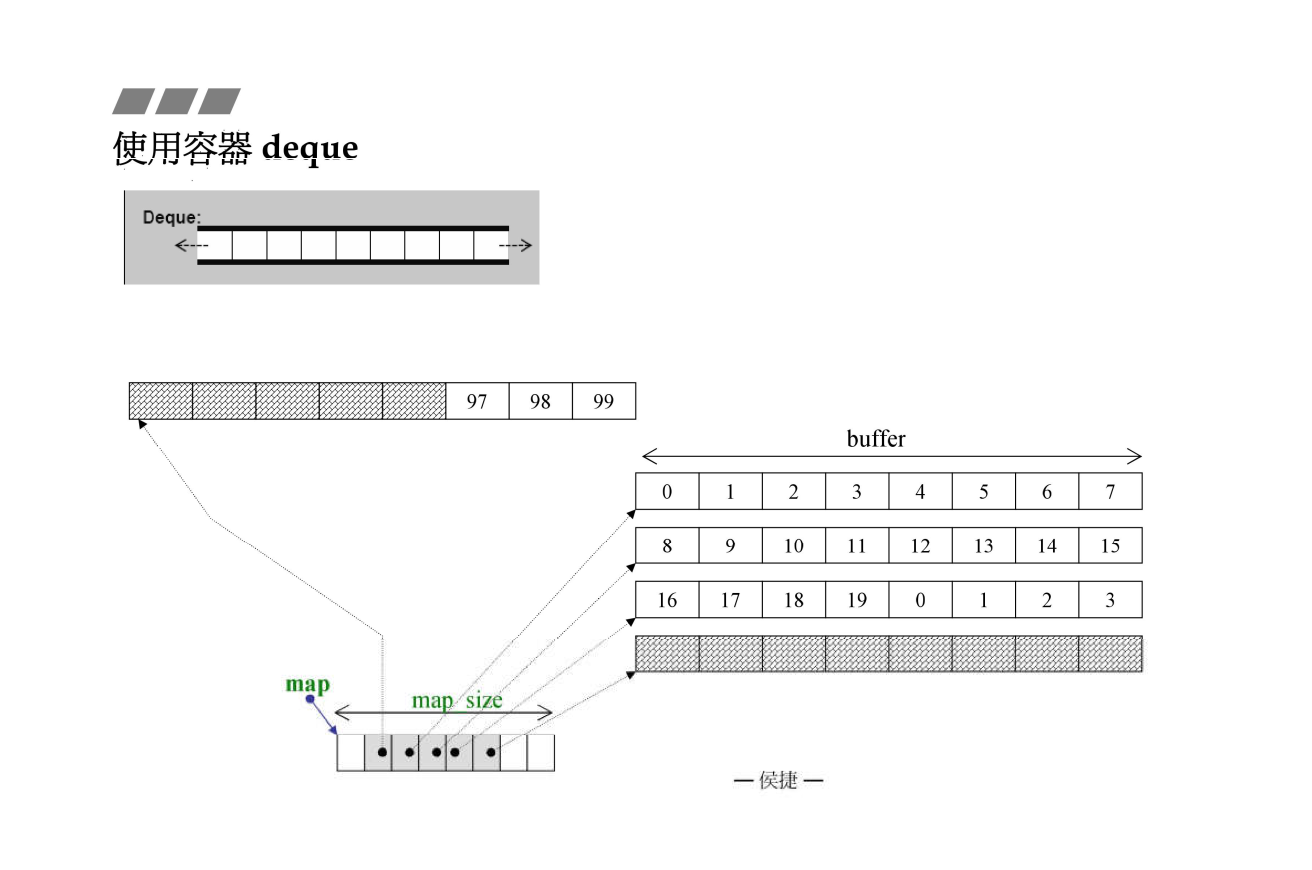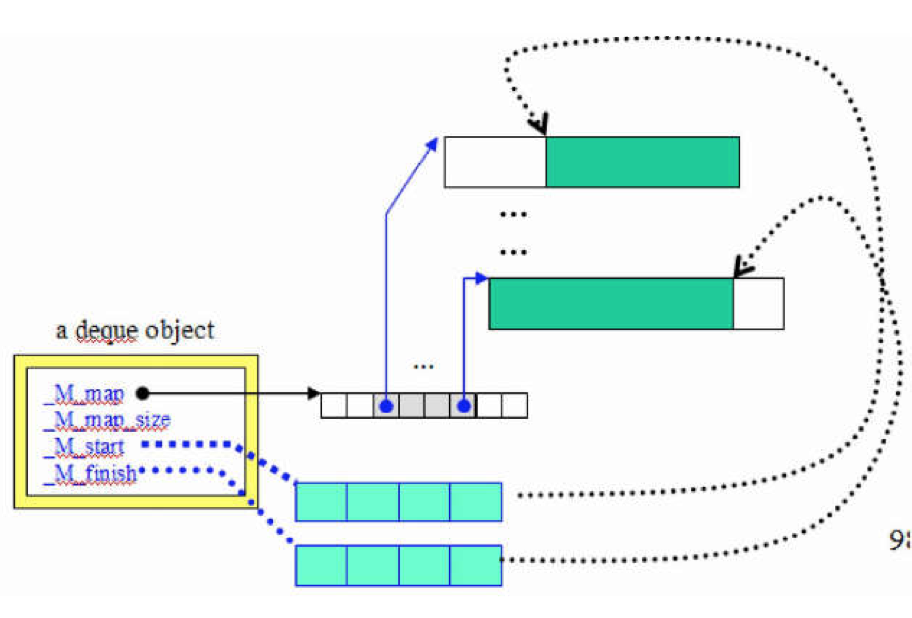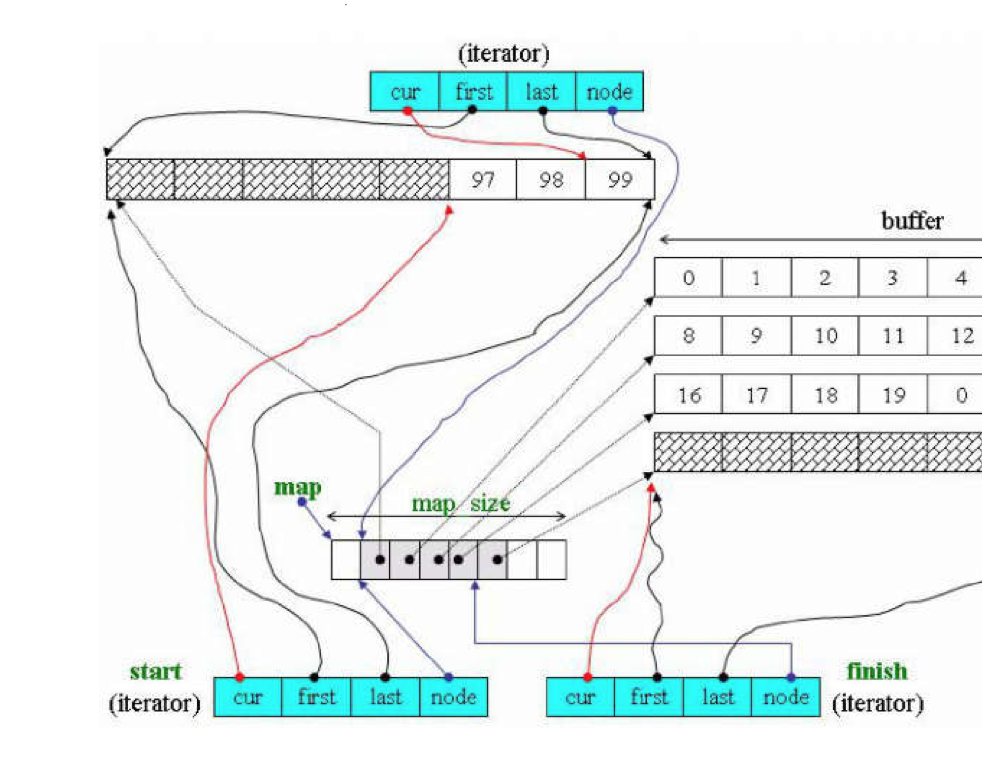STL标准库-容器-deque
技术在于交流、沟通,本文为博主原创文章转载请注明出处并保持作品的完整性。
deque双向开口可进可出的容器

我们知道连续内存的容器不能随意扩充,因为这样容易扩充别人那去
deque却可以,它创造了内存连续的假象.
其实deque由一段一段构成 ,他是分段连续,而不是内存连续 当走向段的尾端时候自动跳到下一段 所以支持迭代器++ 操作,自动跳到下一段的方法由operator++实现
deque每次扩充 申请一个段

一 定义
头文件 #include <deque>
int main_0() {
//默认构造函数 创建一个空的deque
deque<int> c;
//拷贝构造
deque<int> c1(c);
//赋值拷贝
deque<int> c2 = c1;
//指定元素个数创建
deque<int> c3 (,);
for (auto i : c3) {
cout<< i << ",";
}
cout << "deque(个数, 元素)"<<endl;
//指定区间创建
deque<int> c4(c3.begin()+, c3.begin()+);
for (auto i : c4) {
cout<< i << ",";
}
cout << "deque(区间, 区间)"<<endl;
//指定初始化列表创建
deque<int> c5({,,,});
for (auto i : c5) {
cout<< i << ",";
}
cout << "deque({})"<<endl;
//指定初始化列表创建
deque<int> c6 = {,,,};
for (auto i : c6) {
cout<< i << ",";
}
cout << "deque = {}" <<endl;
cout<<endl;
return ;
}
二 操作
int main()
{
deque<int> c = {,,,,};
deque<int> c1; // 赋值初始化
c1.assign(c.begin(),c.end());
for (auto i: c1) {
cout<< i << ",";
}
cout << "assign()" <<endl; //在尾部插入
c1.push_back();
for (auto i: c1) {
cout<< i << ",";
}
cout << "push_back()" <<endl; //头插入
c1.push_front();
for (auto i: c1) {
cout<< i << ",";
}
cout << "push_front()" <<endl; //弹尾元素
c1.pop_back();
for (auto i: c1) {
cout<< i << ",";
}
cout << "pop_back()" <<endl; //弹头元素
c1.pop_front();
for (auto i: c1) {
cout<< i << ",";
}
cout << "pop_front()" <<endl; //指定位置插入元素
c1.insert(c1.begin()+, );
for (auto i: c1) {
cout<< i << ",";
}
cout << "insert()" <<endl; //删除指定位置元素
c1.erase(c1.begin()+);
for (auto i: c1) {
cout<< i << ",";
}
cout << "erase()" <<endl; //清空deque
c.clear();
for (auto i: c) {
cout<< i << ",";
}
cout << "clear()" <<endl; //构造
c1.emplace(c1.end(), );
for (auto i: c1) {
cout<< i << ",";
}
cout << "emplace()" <<endl; //头位置插入元素
c1.emplace_front();
for (auto i: c1) {
cout<< i << ",";
}
cout << "emplace_front()" <<endl; //尾位置插入元素
c1.emplace_back();
for (auto i: c1) {
cout<< i << ",";
}
cout << "emplace_back()" <<endl; //交换
c.swap(c1);
for (auto i: c) {
cout<< i << ",";
}
cout << "swap()" <<endl; int tmp;
tmp = c.front();
cout<<"第一个元素"<< tmp << endl; tmp = c.back();
cout<<"最后一个元素"<< tmp << endl; tmp = c.at();
cout<<"指定下标元素"<< tmp << endl; tmp = c[];
cout<<"指定[]下标元素"<< tmp << endl; return ;
}
三 内存
int main()
{
deque<int> c = {,,,,}; //元素个数
cout<< "size(): " << c.size() <<endl; //重新设定deque大小 少退多补
c.resize(, );
for(auto i : c)
{
cout << i <<",";
}
cout << "resize()" << endl; //最大容量
cout << "max_size(): " << c.max_size() <<endl; //是否为空
cout << "empty: " << c.empty() << endl; //清空内存
c.shrink_to_fit(); return ;
}
五 与迭代器操作
int main()
{
deque<int> c = {,,,,};
//指向第一个元素的迭代器
cout << *c.begin() << endl;
//指向最后一个元素的下一个位置的迭代器
cout << *c.end() << endl;
//反向deque的第一个元素的迭代器
cout << *c.rbegin() << endl;
//反向deque的第一个元素的上一个位置迭代器
cout << *c.rend() << endl;
//指向第一个元素的迭代器
cout << *c.cbegin() << endl;
//指向最后一个元素的下一个位置的迭代器
cout << *c.cend() << endl;
//反向deque的第一个元素的迭代器
cout << *c.crbegin() << endl;
//反向deque的第一个元素的上一个位置迭代器
cout << *c.crend() << endl; return ;
}
Soource Code
deque的类图如下,跟vector的类图结构相似

_Deque_base<_Tp>基类
template<typename _Tp, typename _Alloc>
class _Deque_base
{
...
struct _Deque_impl
: public _Tp_alloc_type
{
_Tp** _M_map;
size_t _M_map_size;
iterator _M_start;
iterator _M_finish;
}
...
}
_Deque_impl<_Tp>数据类
成员变量含义,如下图所示
_M_map指向存储 指向内存的指针 的连续内存
_M_map_size表示_M_map指向的内存大小(有多少个buffer)
_M_start指向_M_map指向内存起始点的迭代器
_M_finish指向_M_map指向内存结束点的迭代器

deque<_Tp>
template<typename _Tp, typename _Alloc = std::allocator<_Tp> >
class deque : protected _Deque_base<_Tp, _Alloc>
{
//成员变量含义与vector成员变量含义相似
public:
typedef _Tp value_type;
typedef typename _Tp_alloc_type::pointer pointer;
typedef typename _Tp_alloc_type::const_pointer const_pointer;
typedef typename _Tp_alloc_type::reference reference;
typedef typename _Tp_alloc_type::const_reference const_reference;
typedef typename _Base::iterator iterator;
typedef typename _Base::const_iterator const_iterator;
typedef std::reverse_iterator<const_iterator> const_reverse_iterator;
typedef std::reverse_iterator<iterator> reverse_iterator;
typedef size_t size_type;
typedef ptrdiff_t difference_type;
typedef _Alloc allocator_type;
...
//这个函数返回buffer大小
static size_t _S_buffer_size() _GLIBCXX_NOEXCEPT
{ return __deque_buf_size(sizeof(_Tp)); }
}
//它的实现如下
#ifndef _GLIBCXX_DEQUE_BUF_SIZE
#define _GLIBCXX_DEQUE_BUF_SIZE 512
#endif
inline size_t
__deque_buf_size(size_t __size)
{ return (__size < _GLIBCXX_DEQUE_BUF_SIZE
? size_t(_GLIBCXX_DEQUE_BUF_SIZE / __size) : size_t()); }
/*
如果是deque<int>的话 上面的函数可以翻译成 4 < 512 ? size_t(512/4) " size_t(1)
结果就是512/4 = 128
那么每个buffer所含value_type的个数就128,即一个buffer能存128个int
deque<double> 的话就是512/8 = 64 那么每个buffer的所含个数就是64
如果>=512 就是每个buffer只能存1个 (class/array/struct)
*/
解析一个成员函数insert(),在解析之前介绍一下它的迭代器成员变量的含义

start 指向头的迭代器(_M_start)
finish 指向尾部的下一个位置的迭代器(_M_finish)
cur 指向当前元素
first 指向当前buffer内的第一个元素
last 指向单钱buffer的最后一个元素
node 指向当前buffer的指针
map_size node的个数
insert(const_iterator __position, value_type&& __x)
{ return emplace(__position, std::move(__x)); }
empalce()
template<typename _Tp, typename _Alloc>
template<typename... _Args>
typename deque<_Tp, _Alloc>::iterator
deque<_Tp, _Alloc>::
emplace(const_iterator __position, _Args&&... __args)
{
if (__position._M_cur == this->_M_impl._M_start._M_cur) //插入的位置是否在最前端
{
emplace_front(std::forward<_Args>(__args)...);
return this->_M_impl._M_start;
}
else if (__position._M_cur == this->_M_impl._M_finish._M_cur)//插入的位置在最尾端
{
emplace_back(std::forward<_Args>(__args)...);
iterator __tmp = this->_M_impl._M_finish;
--__tmp;//迭代器指向的是最尾端的下一个位置
return __tmp;
}
else
return _M_insert_aux(__position._M_const_cast(),
std::forward<_Args>(__args)...);
}
emplace_front()
template<typename _Tp, typename _Alloc>
template<typename... _Args>
void
deque<_Tp, _Alloc>::
emplace_front(_Args&&... __args)//插入在最前端
{
if (this->_M_impl._M_start._M_cur != this->_M_impl._M_start._M_first)//如果最前端的buffer内存够的话
{
this->_M_impl.construct(this->_M_impl._M_start._M_cur - ,
std::forward<_Args>(__args)...);//直接在备用空间上构造元素
--this->_M_impl._M_start._M_cur;//调整cur
}
else //如过内存不够
_M_push_front_aux(std::forward<_Args>(__args)...);
} #if __cplusplus >= 201103L
template<typename... _Args>
void
deque<_Tp, _Alloc>::
_M_push_front_aux(_Args&&... __args)
#else
void
deque<_Tp, _Alloc>::
_M_push_front_aux(const value_type& __t)
#endif
{
_M_reserve_map_at_front();
*(this->_M_impl._M_start._M_node - ) = this->_M_allocate_node();//申请空的头结点
__try
{
this->_M_impl._M_start._M_set_node(this->_M_impl._M_start._M_node
- ); //改变start,令其指向新节点
this->_M_impl._M_start._M_cur = this->_M_impl._M_start._M_last - ; ////改变cur,
#if __cplusplus >= 201103L
this->_M_impl.construct(this->_M_impl._M_start._M_cur,
std::forward<_Args>(__args)...);//复制
#else
this->_M_impl.construct(this->_M_impl._M_start._M_cur, __t);
#endif
}
__catch(...)
{
++this->_M_impl._M_start;
_M_deallocate_node(*(this->_M_impl._M_start._M_node - ));
__throw_exception_again;
}
}
_M_insert_aux
#if __cplusplus >= 201103L
template<typename... _Args>
typename deque<_Tp, _Alloc>::iterator
deque<_Tp, _Alloc>::
_M_insert_aux(iterator __pos, _Args&&... __args)
{
value_type __x_copy(std::forward<_Args>(__args)...); // XXX copy
#else
typename deque<_Tp, _Alloc>::iterator
deque<_Tp, _Alloc>::
_M_insert_aux(iterator __pos, const value_type& __x)
{
value_type __x_copy = __x; // XXX copy
#endif
difference_type __index = __pos - this->_M_impl._M_start;//重在operator- 返回距起始端距离 安插点之前的元素个数
if (static_cast<size_type>(__index) < size() / )//若果插入点在整体内存的前半段,插入后整体内存前移
{
push_front(_GLIBCXX_MOVE(front()));//复制头buffer的一个元素
iterator __front1 = this->_M_impl._M_start;//取出头迭代器位置,和下一个节点的起始点
++__front1;
iterator __front2 = __front1;
++__front2;
__pos = this->_M_impl._M_start + __index;
iterator __pos1 = __pos;
++__pos1;
_GLIBCXX_MOVE3(__front2, __pos1, __front1);//front1 到 front2 这段区间内的前pos1个元素向前移动一个单位 (留出一个单位给将插入的的元素)
}
else
{
push_back(_GLIBCXX_MOVE(back()));
iterator __back1 = this->_M_impl._M_finish;
--__back1;
iterator __back2 = __back1;
--__back2;
__pos = this->_M_impl._M_start + __index;
_GLIBCXX_MOVE_BACKWARD3(__pos, __back2, __back1);
}
*__pos = _GLIBCXX_MOVE(__x_copy); //复制元素
return __pos;
}
既然说deque是模仿内存连续,实现这种功能的主要功臣是deque的迭代器,说道迭代器 那么我们一定会联想到迭代器的操作符重载,下面我主要介绍迭代器的操作符重载
operator* 这个比较好理解 返回cur指向的元素
reference
operator*() const _GLIBCXX_NOEXCEPT
{ return *_M_cur; } pointer
operator->() const _GLIBCXX_NOEXCEPT
{ return _M_cur; }
operator++()(前++)与operator++(int)
_Self&
operator++() _GLIBCXX_NOEXCEPT
{
++_M_cur;
if (_M_cur == _M_last)//如果++到达该节点尾端
{
_M_set_node(_M_node + );//跳至下一个节点
_M_cur = _M_first;
}
return *this;
} _Self
operator++(int) _GLIBCXX_NOEXCEPT
{
_Self __tmp = *this;
++*this;//调用前++
return __tmp;
}
operator--()与operator--(int)
_Self&
operator--() _GLIBCXX_NOEXCEPT
{
if (_M_cur == _M_first)//如果--后到达头端
{
_M_set_node(_M_node - );//跳至前一个节点
_M_cur = _M_last;
}
--_M_cur;
return *this;
} _Self
operator--(int) _GLIBCXX_NOEXCEPT
{
_Self __tmp = *this;
--*this;
return __tmp;
}
operator+=(itn) ,+,-=,-
_Self&
operator+=(difference_type __n) _GLIBCXX_NOEXCEPT
{
const difference_type __offset = __n + (_M_cur - _M_first);//查找位置
if (__offset >= && __offset < difference_type(_S_buffer_size()))//查找位置是否小于一个buffer的容量(在当前buffer内)
_M_cur += __n;
else
{
const difference_type __node_offset =
__offset > ? __offset / difference_type(_S_buffer_size())
: -difference_type((-__offset - )
/ _S_buffer_size()) - ;
_M_set_node(_M_node + __node_offset);//切换至正确buffer
_M_cur = _M_first + (__offset - __node_offset
* difference_type(_S_buffer_size()));
}
return *this;
}
_Self
operator+(difference_type __n) const _GLIBCXX_NOEXCEPT
{
_Self __tmp = *this;
return __tmp += __n;//调用+=
}
_Self&
operator-=(difference_type __n) _GLIBCXX_NOEXCEPT
{ return *this += -__n; }//调用+=
_Self
operator-(difference_type __n) const _GLIBCXX_NOEXCEPT
{
_Self __tmp = *this;
return __tmp -= __n;
}
operator[],和_M_set_node
reference
operator[](difference_type __n) const _GLIBCXX_NOEXCEPT
{ return *(*this + __n); }
/**
* Prepares to traverse new_node. Sets everything except
* _M_cur, which should therefore be set by the caller
* immediately afterwards, based on _M_first and _M_last.
*/
void
_M_set_node(_Map_pointer __new_node) _GLIBCXX_NOEXCEPT//切换至正确buffer
{
_M_node = __new_node;
_M_first = *__new_node;
_M_last = _M_first + difference_type(_S_buffer_size());
}
参考<<侯捷STL标准库>>
STL标准库-容器-deque的更多相关文章
- STL标准库-容器-deque 双端队列
头文件: #include<deque> 常用操作: https://www.cnblogs.com/LearningTheLoad/p/7450948.html
- STL标准库-容器-set与map
STL标准库-容器-set与multiset C++的set https://www.cnblogs.com/LearningTheLoad/p/7456024.html STL标准库-容器-map和 ...
- STL标准库-容器-set与multiset
技术在于交流.沟通,转载请注明出处并保持作品的完整性. set与multiset关联容器 结构如下 set是一种关联容器,key即value,value即key.它是自动排序,排序特点依据key se ...
- STL标准库-容器-vector
技术在于交流.沟通,本文为博主原创文章转载请注明出处并保持作品的完整性. 向量容器vector是一个动态数组,内存连续,它是动态分配内存,且每次扩张的原来的二倍. 他的结构如下 一 定义 vector ...
- STL标准库-容器-list
技术在于交流.沟通,本文为博主原创文章转载请注明出处并保持作品的完整性. list 表示非连续的内存区域,并通过一对指向首尾元素的指针双向链接起来,从而允许向前和向后两个方向进行遍历.在list 的任 ...
- STL标准库-容器适配器
技术在于交流.沟通,本文为博主原创文章转载请注明出处并保持作品的完整性 上一节介绍了仿函数适配器,这节主要介绍容器适配器和迭代器适配器的概念,其实容器适配器和迭代器其适配器就是封装了一些其他class ...
- STL标准库-容器-rb_tree
技术在于交流.沟通,本文为博主原创文章转载请注明出处并保持作品的完整性 红黑树,关联式容器底层实现(map set),在使用中基本运用不到,但是还是想了解一下他的运作方式 Red_Black tree ...
- STL标准库-容器-unordered_set
技术在于交流.沟通,本文为博主原创文章转载请注明出处并保持作品的完整性 unordered_set与与unordered_map相似,这次主要介绍unordered_set unordered_set ...
- STL标准库-容器-map和multimap
技术在于交流.沟通,本文为博主原创文章转载请注明出处并保持作品的完整性 map与multimap为关联容器,结构如下 map底层实现依然是rb_tree 他的data可以改,但是key不能改,因此ma ...
随机推荐
- mysql 数据操作 单表查询 查询排序: order by
如果不指定排序 默认是按照id字段 从小到大排序的 升序 mysql> select * from employee; +----+------------+--------+-----+-- ...
- 【Lua】面向对象编程(一)
类和对象: account.lua module(...,package.seeall) Account={balance=} Account.new=function(self,o) local ...
- 6.1 Controllers -- Introduction
一.Controllers 1. 在Ember.js中,controllers允许你使用展现逻辑装饰你的models.通常,models将会有保存到服务器的属性,然而controllers将会有不需要 ...
- C++多线程学习资料参考
新的C++11语法:<Professional C++>,或<C ++ Primer Plus>: C++11多线程:<C++ Concurrency in Actio ...
- JFreeChart DateAxis用法
http://blog.csdn.net/xiaozhendong123/article/details/50131513
- 前端学习笔记之HTTP协议
阅读目录 一 HTTP协议简介 二 HTTP协议之请求Request 三 HTTP协议之响应Response 四 HTTP协议完整工作流程 五 HTTP协议关键性总结 六 自定义套接字分析HTTP协议 ...
- oracle数据库中导入Excel表格中的数据
1.点击[工具]-->[ODBC 导入器],如图: 2.在导入器里选择第一个[来自ODBC的数据],用户名/系统DSN-->填写[Excel Files],输入用户名和密码,点击 [连接] ...
- 20145325张梓靖 《Java程序设计》第8周学习总结
20145325张梓靖 <Java程序设计>第8周学习总结 教材学习内容总结 Logger java.util.logging包提供了日志功能相关类与接口,使用日志的起点是logger类, ...
- cygwin安装方法
一.环境 OS:windows 二.安装cygwin以及各类cygwin下的软件 2.1 从官网http://www.cygwin.com/获取最新的版本 2.2 安装过程如下图
- Ubuntu 安装zookeeper
下载zookeeper Zookeeper下载 下载以后将文件迁移到/home/Hadoop/文件夹下面 hongdada@ubuntu:~/Downloads$ sudo mv zookeepe ...
